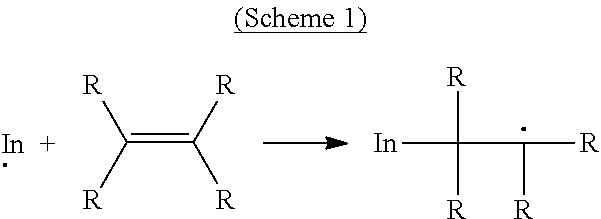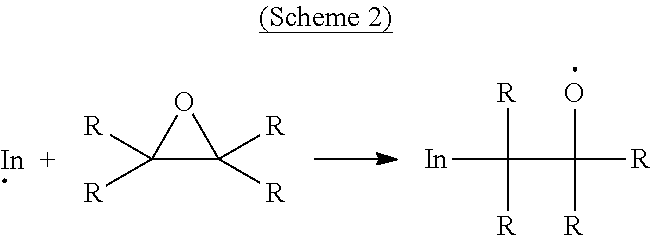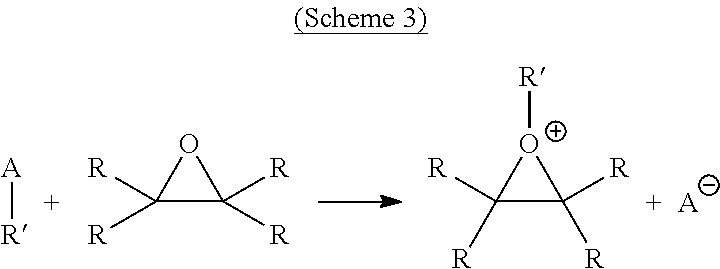Curable formulation
a formulation and cure technology, applied in the field of cureable formulations, can solve the problems of cross-linked materials, incomplete curing, and comparatively limited storage life of many drying formulations, and achieve the effect of high viscosity
- Summary
- Abstract
- Description
- Claims
- Application Information
AI Technical Summary
Benefits of technology
Problems solved by technology
Method used
Image
Examples
example 1a
Preparation of a Cationically Photocurable Formulation I
[0211]A cationically photocurable flexographic ink formulation I according to the present invention was prepared as follows:
[0212]The methyl ester of epoxidized linseed oil was prepared, to function as a cationically curable resin, as follows:
[0213]Linseed oil was obtained from flax seeds by cold pressing using a screw filter press.
[0214]In their raw state, many plant oils, such as linseed oil, are known to comprise a mixture of fatty-acid based components. The fatty acid-based components exist predominantly as fatty acid triglycerides, with smaller proportions of di- and monoglycerides, and free fatty acids. The oils contain both mixed triglycerides and diglycerides (based upon more than one fatty acid) and triglycerides and diglycerides based upon a single fatty acid. The composition of plant oils may be expressed in terms of the equivalent molar percentages of the free fatty acids, that is to say the molar percentages of the...
example 1b
Preparation of Cationically Photocurable Ink Formulation II
[0223]A cationically photocurable flexographic ink formulation according to the present invention was prepared as follows:
[0224]A first resin of epoxidized hemp oil was prepared.
[0225]A second resin of the methyl ester of epoxidized linseed oil was prepared.
[0226]Hemp oil was obtained from hemp seeds by cold pressing using a screw filter press.
[0227]Linseed oil was similarly obtained from flax seeds.
[0228]Hemp oil typically comprises approximately 8% oleic acid, approximately 54% linoleic acid and approximately 20% α-linolenic acid. Smaller amounts of other fatty acids are also present.
[0229]Linseed oil typically comprises approximately 19% oleic acid, 24% linoleic acid and 47% α-linolenic acid (an 18:3 fatty acid). Small amounts of other fatty acids are also present.
[0230]The procedure for epoxidising unsaturated plant oils will be well-known to those skilled in the art. The example below is given by way of illustration and...
example 1c
Preparation of Cationically Thermally Curable Varnish Formulation III
[0238]A cationically thermally curable flexographic varnish formulation according to the present invention was prepared as follows:
[0239]A first resin of epoxidized linseed oil, and a second resin of the methyl ester of epoxidized linseed oil, were prepared according to the methods discussed above.
[0240]The first resin (epoxidized linseed oil) had a viscosity of approximately 500 cP at 25° C. The viscosity of linseed oil (epoxidized or in its raw state) typically falls in the range 350 cP-600 cP and therefore the relative proportions of linseed oil and the methyl ester of linseed oil may be adjusted accordingly.
[0241]The methyl ester of epoxidised linseed oil had a viscosity of less than 5 cP at 25° C.
[0242]Flexographic varnish formulation III was then prepared by mixing the resins with quantities of soya oil (soya oil typically comprising approximately 25% oleic acid, approximately 55% linoleic acid approximately ...
PUM
| Property | Measurement | Unit |
|---|---|---|
| viscosities | aaaaa | aaaaa |
| viscosities | aaaaa | aaaaa |
| viscosities | aaaaa | aaaaa |
Abstract
Description
Claims
Application Information
 Login to View More
Login to View More - R&D
- Intellectual Property
- Life Sciences
- Materials
- Tech Scout
- Unparalleled Data Quality
- Higher Quality Content
- 60% Fewer Hallucinations
Browse by: Latest US Patents, China's latest patents, Technical Efficacy Thesaurus, Application Domain, Technology Topic, Popular Technical Reports.
© 2025 PatSnap. All rights reserved.Legal|Privacy policy|Modern Slavery Act Transparency Statement|Sitemap|About US| Contact US: help@patsnap.com



